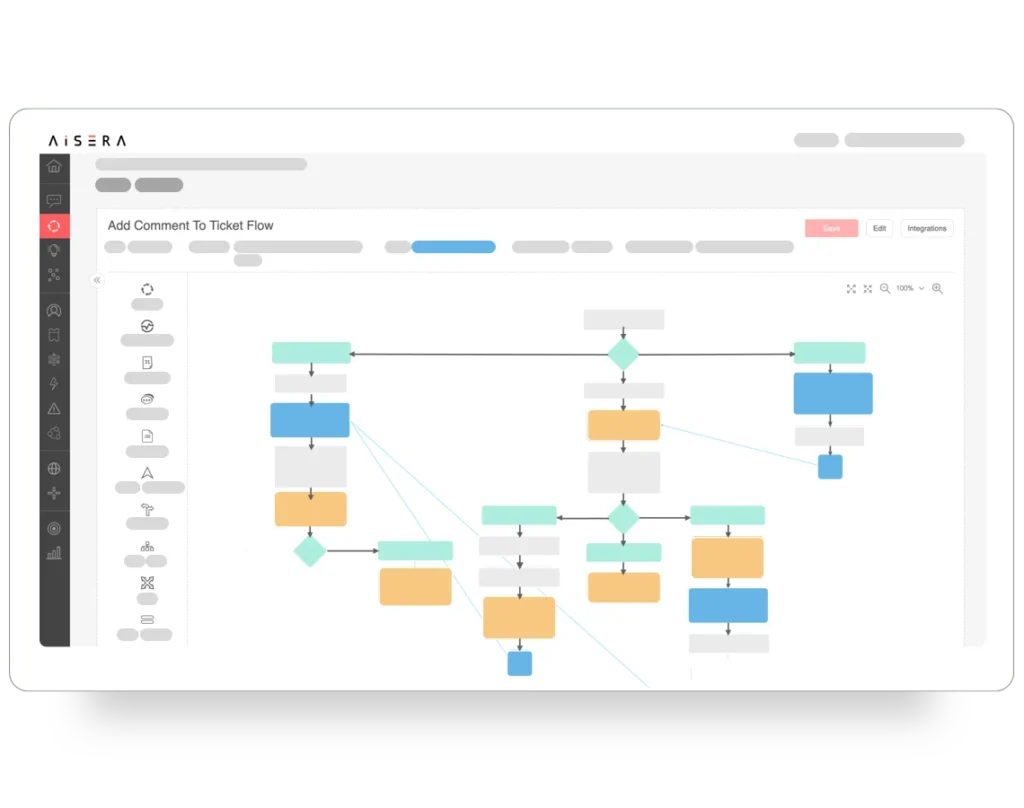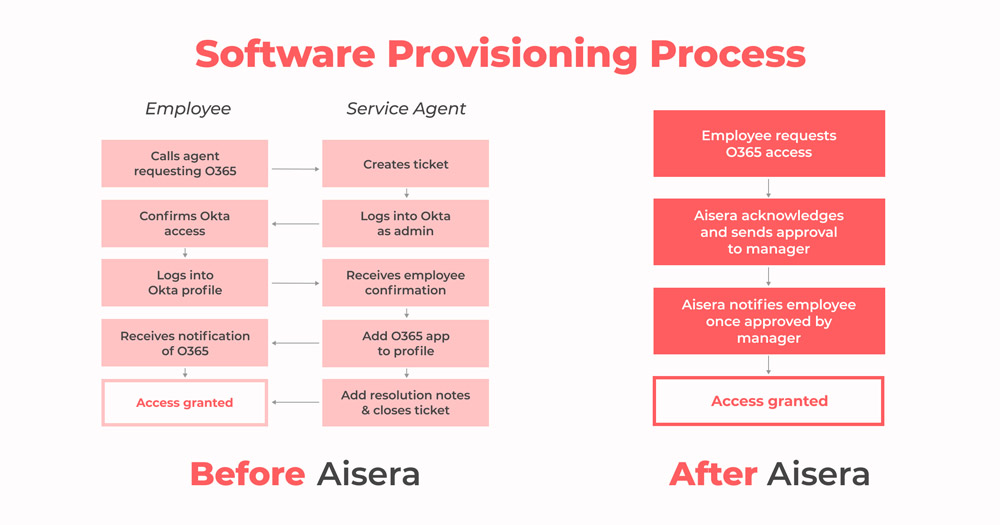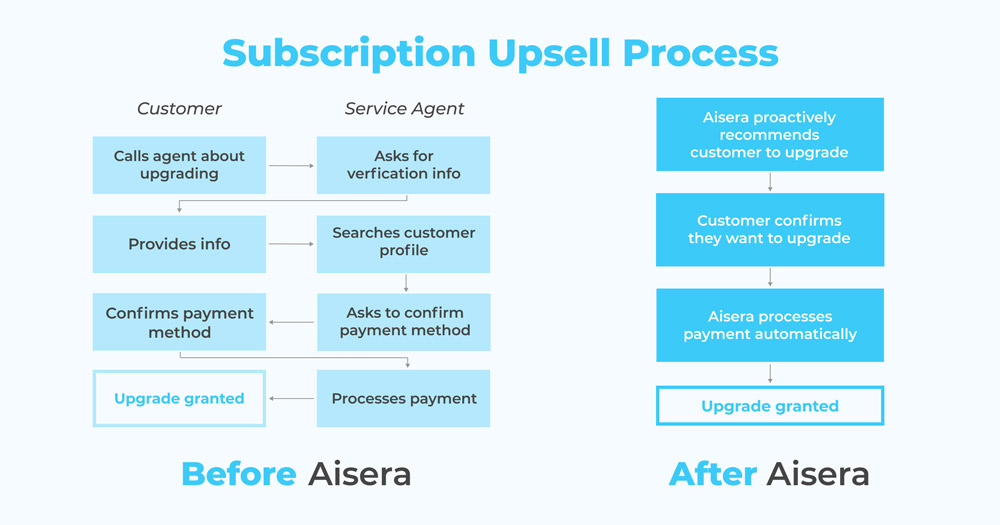Introduction to AI Workflows
Whatever your size or industry, AI workflow automation will permanently and profoundly change the paradigm of how your enterprise services function.
The revolution is now in full force and gaining momentum. More than anywhere else, AI workflow automation solutions are sweeping the strategic business decision-making that affects an enterprise’s productivity and long-term efficiency.
What is AI Workflow Automation?
Artificial Intelligence Workflow Automation simplifies and improves existing business processes that are often manual and human-dependant.
What does that mean?
For one, it allows for the encoding of more processes into systems with AI and other automation tools, which can then be efficiently performed autonomously. Only recently, as more processes become encoded into these systems, the automating of workflows was becoming a staple for enterprises embarking on their digital transformation journeys.
With the ruthless onset of the COVID-19 pandemic, Artificial Intelligence workflows flashed from a popular trend to a dire emergency. Survival itself became an issue for many businesses, and that meant moving faster to optimize and manage workflows than had ever been imagined as the staggering consequences of the pandemic began to impact the economy.
A year down the line, and under unrelenting pressure, an automated AI Workflow has emerged as an almost incalculably powerful engine of opportunities to thrive and grow. First of all, it simplifies workflows by improving the efficiency of your existing processes.
Optimizing these workflows and streamlining operations demand accurate, relevant data—and aggregating that data manually was never an option, given the volumes of information residing online and offline. So AI technology and particularly machine learning naturally have become the only actionable avenues to automated data sets and workflows.
AI Workflow Orchestration Explained
Since its inception, AI, or artificial intelligence, has been applied in endless different fields and solutions. Among these various applications, AI models have played an essential role in one particular area: Workflow Orchestration.
The introduction of AI Workflow Orchestration technology into the modern workplace is making leaps and bounds, bringing tremendous business value to organizations. But what is it exactly? We’ll do a deep dive into AI Workflow automation and Orchestration to give you all the details you’ll want to know.
To get started, it’s important first to understand what workflow orchestration is. Workflow Orchestration is the process of arranging a series of steps or the various tasks necessary to perform an action.
What does data orchestration involve? Data orchestration focuses on supervising and coordinating data warehousing procedures, incorporating both workflow orchestration and dataflow automation as essential elements.
For example, a typical data pipeline or workflow orchestration in an organizational setting would be granting a user needing access to a specific application, a data process also known as application provisioning.
In a typical environment, there are multiple back-and-forth steps between the user requesting access to the application and a service agent, requiring multiple instances of questions and responses on both ends to complete the workflow. It doesn’t take a trained eye to see how error-prone, inflexible, inefficient, and outmoded this process can be. The constant back-and-forth is purely unsustainable, especially for rapidly scaling companies.
Where does AI fit into this all? AI workflow is the intelligent automation of these painful workflows. Incorporating Generative AI (GenAI) into workflow orchestration removes the need for back-and-forth communication between the user and the AI agents in an agentic AI system.
By 2025, 50% of enterprises will have devised artificial intelligence (AI) orchestration platforms to operationalize AI, up from fewer than 10% in 2020. – Gartner 2021

The Path to AI Workflow Automation
In summary, when you consider Artificial Intelligence Workflow Automation, first identify your goals—are they cost-related? Engagement and employee satisfaction related? Efficiency-related? Then define the roles that your team members play in your adoption of AI automation: what they are in charge of, and what their respective responsibilities are. And lastly, make sure that everybody understands these goals and responsibilities as you move into the new terrain of AI Workflow Automation.
Set KPIs to evaluate how well your project is moving toward fruition: are process times falling in comparison to previous methods, for example? Decide on your measurements of success. AI is the route that will take you from Robotic Process Automation (RPA) and its scripts to an advanced communications system that simulates an actual human interaction with dazzling accuracy.
Powered by advanced Natural Language Processing (NLP) and Natural Language Understanding (NLU), Conversational RPA and AI Workflow Automation are actually advanced and sophisticated enough now to simplify every life they touch.
Machine Learning and Automating IT Workflows
In addition to the omnichannel, the AI Workflow Automation platform supports IT services by enabling real-time self-service with quick solutions to common issues. Self-service with Conversational AI and RPA lets users problem-solve in far less time than they would spend with an agent.
A sophisticated system like Aisera’s AI Service Desk expedites contact with a human agent if an issue can’t be solved by self-service, delivering a superior user experience. Agents are relieved of the tedium and monotony of helping users with password resets and other mundane matters and can put their skills to use on higher-value tasks.
Practically speaking, ticket volumes decline dramatically while user satisfaction scores rise. Agents can engage customers in more productive conversations and register higher morale as well with consequent drops in attrition rates and a brighter operations picture overall from loyalty and job satisfaction.
Business processes are the foundation of an organization. These processes are so ubiquitous that people take them for granted. However, they generate the rich repository of encoded data that AI uses as its foundational resource.
AI and machine learning give all this the value of intelligence. AI can process mass data from a wide range of structured and unstructured sources in different formats and languages. Intelligent, AI-enabled business processes improve service to customers, partners, suppliers, and employees, moving away from rigidly defined workflows to true AI Workflow Automation—highly intelligent and autonomous.
Enterprises today are continuously evolving to remain competitive and thrive in a multifaceted environment. AI enables machine learning to self-educate continually over time to ensure constantly optimizing outcomes.
Optimize and Streamline Workflows
Artificial Intelligence Workflow Automation simplifies and improves existing business processes that are often manual and human-dependant.
What does that mean? For one, it allows for the encoding of more processes into systems with GenAI and other automation tools, which can then be efficiently performed autonomously. Only recently, as more processes become encoded into these systems, the automating of workflows was becoming a staple for enterprises embarking on their digital transformation journeys.
With the ruthless onset of the COVID-19 pandemic, Artificial Intelligence workflows flashed from a popular trend to a dire emergency. Survival itself became an issue for many businesses, and that meant moving faster to optimize and manage workflows than had ever been imagined as the staggering consequences of the pandemic began to impact the economy.
A year down the line, and under unrelenting pressure, automated AI Workflows have emerged as an almost incalculably powerful engine of opportunities to thrive and grow. First of all, it simplifies workflows by improving the efficiency of your existing processes.
Optimizing these workflows and streamlining operations demand accurate, relevant data—and aggregating that data manually was never an option, given the volumes of information residing online and offline. So GenAI and machine learning naturally have become the only actionable avenues to automated data sets and workflows.
Automate Repetitive, Manual Service Desk Tasks
Ever since businesses gained the ability to aggregate and organize data quickly—and even before the digital era—it became apparent that redundant, repetitive manual tasks were a major roadblock to competitiveness, agility, accurate prediction-making, and forecasting for growth. The need to streamline processes is nothing new and even pre-dated (and inspired) the Industrial Revolution.
Manual, repetitive tasks waste time and the human spirit, trapping people in morale-destroying ruts and raising the incidence of error. So early on, a top priority emerged to automate as many menial tasks as possible. Using mass data to automate tasks and processes has proven the best route to survival, productivity, and growth. Digital recording and storing of information naturally gave rise to fertile new ideas for manipulating that information in a dizzying range of ways.
Today, the resulting responsive, flexible workflows can adapt in near real-time even to unexpected changes and fast-rising new demands—fostering efficiency and enhancing productivity. AI Workflow Automation improves user productivity up to ten times.
Putting AI Workflow Automation to Work for You
The recipe for implementing AI workflow automation has three major ingredients:
- Recognize patterns from your big data
- Make decisions about the goals you want to reach based on this recognition
- Take action
These simple instructions call for some strategic and innovative thinking. But there are markers along the way to help guide your decision-making. For one, in today’s vast and dynamic global marketplace, the omnichannel has taken unchallenged command of communications, enabling accessibility to customers across the enterprise at every touchpoint, both online and offline. Not only is the management of the omnichannel (web portal, chat, email, voice, and mobile apps) vital to sales and service—it is key to gaining and retaining customers and partners.
Conversational Automation & Artificial Intelligence Workflows
This is where Conversational RPA becomes indispensable to conversational automation and workflow automation, enabling users to get the quick attention and answers they need and expect through natural language interaction. Conversational RPA is the route for users to participate, contribute, and make progress. The best part is, that recent advances in Conversational RPA enable the automation of workflows for a natural omnichannel user experience over a convenient Conversational AI Platform interface.
Creating such efficient workflows would be impossible without AI-driven software and machine learning. AI-powered workflow automation offers the enterprise, from casual users to C-level, the ability to streamline and automate complex workflows, tasks, and actions and make better decisions.
Benefits of AI Workflow Tools
AI Workflow Orchestration streamlines everything. It’s as easy as that. AI Workflow orchestration proactively and autonomously enables users to complete actions, serves knowledge, and more. Aided by AI, users are no longer bogged down in a cycle of endless conversations with service agents and can spend their valuable time delivering meaningful tasks.
Additionally, AI Workflow Orchestration addresses the error-prone nature of traditional enterprise workflows. The human factor in conventional enterprise workflows can leave too much room for error. AI-driven solutions for enterprise workflows enter both speed and accuracy into the picture. It doesn’t get any better than that. Organizations can now use AI Orchestration tools to do all the heavy lifting by offloading tasks and actions from service agents and sweeping through hundreds and thousands of user requests.
AI Workflow Orchestration also opens up the doors in these processes for extensive data analysis and insights. The AI-driven solution monitors applications to provide detailed reports and unique insights into various areas of the organization. For example, organizations can utilize this data to track or better understand ROI, providing increased transparency and highlighting potential areas or departments that could benefit from automation next.
The icing on the cake is that these organizations simultaneously improve processes, user experience, and employee engagement while saving on costs. AI Workflow Orchestration drives strong ROI by drastically less time-consuming eliminating errors, improving service agent productivity, and speeding up ticket and request remediation.
All this sounds a little too good to be true, right? Wrong. While the benefits are impressive and, at times, may seem unbelievable, the fact of the matter is that AI is making huge strides in every industry. There has been massive progress in the technology that improves the AI itself or supports growing AI functionality, and we are beginning to see just how much of an impact it has in our daily lives.
AI Workflow Real-world Applications
Now that we’ve gone through the basics of the Workflow AI tool, how can businesses leverage this kind of technology in their everyday operations? The possibilities are endless.
Bringing back to the previous example of application provisioning, AI can enter the equation by just automating the whole process altogether by itself. Instead of a convoluted, back-and-forth process between the employee and service agent, a good AI Workflow Orchestration will only require the employee to request access to the application and the AI will take care of the rest. Take a look at the diagram below.

A proper AI Workflow Orchestration tool simplifies the process by eliminating extra steps, reducing time spent by the employee to get what they need.
That’s an example of an internal process automated by AI workflow, but how does deployment automation of an external process look? Subscription upselling is a large part of how a business generates revenue; however, a traditional subscription upselling and upgrading process can be overly complicated.
In line with the previous example, today’s subscription upselling process is outdated, requiring back-and-forth interaction between the customer and service agent.
AI Workflow Orchestration streamlines the subscription upselling process by doing all the heavy lifting. The AI can recommend a subscription upgrade, and if the customer confirms the recommendation, the AI will take care of the rest of the process. It’s as easy as that. Take a look at the diagram below.

How to Get started with AI Workflow Automation
It’s always challenging to choose the right AI solutions and implement them in an existing system. So, let’s get started by identifying your needs. Does your organization need an internal or external facing solution? Are there any bottlenecks or gaps in your organization’s workflows? Next, look for the solution that’s right for you.
A good AI Workflow builder will effectively reduce your costs, and time spent on tasks and actions and allow you to improve service agent productivity.
Among the modern advancements in automation is Agentic Workflow, which revolutionizes operations by dynamically adapting to complex, non-linear processes through AI-driven decision-making. Aisera’s AI Service Management solution is the industry’s first of its kind. The power of automation for AI customer service and AI for service desk is being harnessed to revolutionize these fields. Forward-thinking companies like Aisera are leading the charge, utilizing AI to transform customer service and service desk operations with unmatched speed and efficiency.
By leveraging key proprietary technologies like Conversational AI, Conversational RPA, Agent Assist, and unsupervised AI, Aisera offers proactive, personalized, and scalable automation solutions spanning AI copilot for IT, HR Copilot, Facilities, Sales, Customer Service, and Operations. Request a custom AI demo today to see how Aisera can deliver top-tier performance for your organization.

